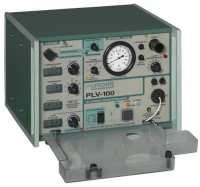I have been ventilated now since 1999 with a PLV.This device
has a somewhat peculiar appearance, but it operates
problemfree regardless of how it's handled.
(proven technology!); it can even tolerate minus
temperatures without any problem. The setting
always ranges between 850ml x 9 breaths per pro min
(lying down) and 900ml x 10 (in a sitting position).
Depending on the level of exertion, I do not
hesitate to have the parameters
changed. I think what is important,
is to be conscious of the ventilation
and to have the values regularly corrected
downwards. One can quickly become
accustomed to hyperventilation and the
subsequent weaning process is not
quite as easy! Initially, I very often
measured the CO2 value of the expired
air and noted that this did not change essentially. The value fluctuates, in my
case, for the aforementioned values, between 27 and 37mmHg
As regards to the respiratory pacemaker (diaphragm pacemaker), attempts were made in my case a few times to activate the phrenic nerve (diaphragm nerve). A surgical test is still to be conducted. If the diaphragm can be electrically stimulated via the phrenic nerve, there is no reason not to use an implant. I have asked for some time to ponder this matter.


